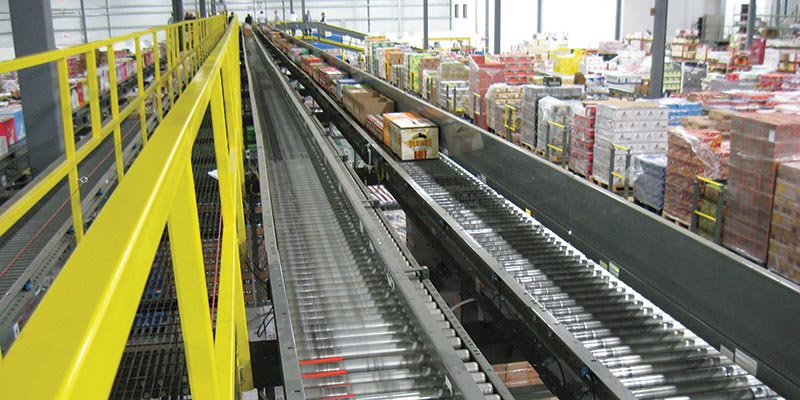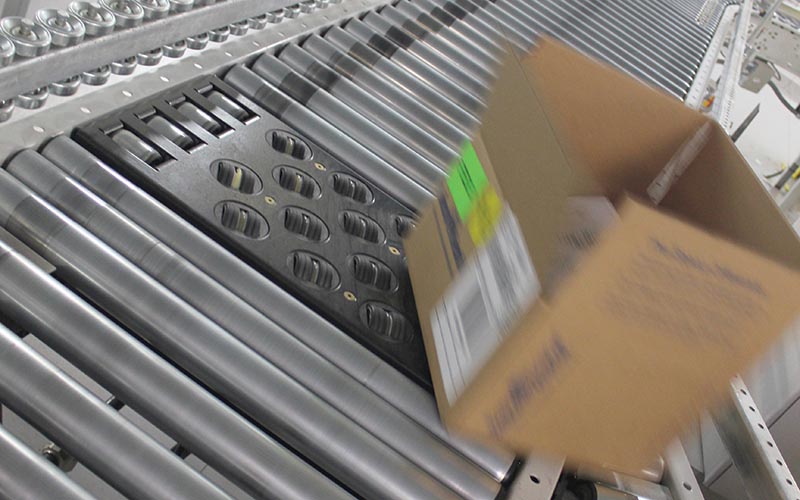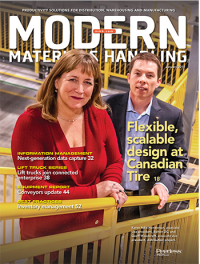Conveyors: A method to the maintenance
In the face of unprecedented demands on equipment, facilities of all sizes are modernizing hardware, software and maintenance strategies.
The latest technologies offer powerful ways to boost speed and accuracy in warehousing and distribution facilities, but in the face of e-commerce, the Amazon effect and fierce competition, the most important metric is uptime.
Instead of “only going to the doctor when something hurts,” connected equipment can ensure any unwelcome operational symptoms are treated promptly and efficiently. As the circulatory system of a facility, conveyor systems are already playing a critical role in the transformation to “smart” operations. Every belt, roller, motor and drive can provide bits of data that add up to a comprehensive, real-time view of the movement of goods down to the individual item.
Until recently, these systems had not been asked to provide any such information. Tom Jensen, senior vice president and general manager at AMK Automation, says the conveyor market of yesteryear was a race to the bottom for the cheapest and most durable.
“What’s a conveyor? A belt and motor that takes something in on one end and moves it out the other,” Jensen explains. “Mostly customers just wanted to turn it on and let it run. The equipment or processes that feed in and out are what drive the conveyor, but the conveyor itself is often just a runner between doorways.”
Not anymore. With uptime as the goal, conveyors with some intelligence are vital not just to the movement of goods, but to the methodology for designing, maintaining and optimizing a system. Five years ago about one in five service calls required a technician be dispatched to the site, says Andy Eckerle, ZiPline Conveyor operations manager for Bastian Solutions. Now, more than 99% of the time it’s possible for system engineers to remotely address any control, software and mechanical issues.
“More customers are treating their system like a PC as opposed to a vehicle,” Eckerle says. To change strategies toward connected, real-time monitoring and preventative maintenance, it takes management to drive from the top down. “They say you can’t teach an old dog new tricks, but we have to teach ourselves and our customers those new tricks,” he adds. “We can no longer run it until it breaks because too much money is at stake.”

Maintenance 2.0
As end-users and solution providers continue to navigate the transition to smart materials handling equipment, they are working to find the balance between detailed data, cost and operational outcomes. Eckerle says progress has been quicker on the software side than the mechanical side.
“We talk about IoT and Industry 4.0, and a lot of that is available, but the customer base isn’t really pushing for that on the mechanical side,” Eckerle says. “We’re also learning what’s truly needed. We can go down to the motor level and look at torque and temperature, but is that truly relevant to running and proactively supporting that system? It’s tough. There’s no industry-wide agreement, and the Amazon effect goes both ways; our customers want it tomorrow, and they want it for free.”
Modernizing maintenance also has a significant cultural impact. Consider Old Fred, a seasoned maintenance professional whose experience and intuition have served his company well for decades in the absence of self-monitoring equipment. A tablet-wielding greenhorn can seem like a threat to Old Fred, who is correct that his vast knowledge and instincts cannot be replaced entirely by software and sensors.
“We can now combine Old Fred and the new connected world,” says Diane Blair, director of international services, training and technical communication for Honeywell Intelligrated. “You have to incorporate Fred in the deployment of new technology. Get his buy-in, because he can be a strong proponent or strong opponent.”
Old Fred will soon learn that new technology helps him turn weeks or months of putting his hand on something until it’s too hot to touch into a much simpler process, Blair says. Meanwhile, the new guys shadowing him can learn how data relates physically to the equipment.
“It’s the same thing Fred used to do manually, but now he has the data to back it up. You can tell a manager motors have been getting hotter, but you can’t spend big bucks to rebuild equipment just because Fred said so,” Blair says. “But you can take that old wisdom and combine it with connected tools to provide Fred with more tricks while validating his knowledge.”
Finding, training and retaining equipment technicians with the right skill set is very, very competitive, Blair says, so solution providers have put tremendous resources into supporting the technicians they have. Connected technicians can train at their own levels, and connected devices give them access to resources and experts.
Anyone can see what the on-site technician is seeing, both in terms of data and the physical condition of the equipment, Blair says. “They’re no longer trying to support blindly,” she adds, “and this can very effectively reduce downtime.”
A connected DC removes guesswork, Blair says, and provides the data to make conscious, predictive steps toward boosting uptime while optimizing maintenance costs.
“It also allows you to do things you never thought of. Say you’re considering rebuilding a 10-year-old linear sorter that’s starting to show some additional vibration, amp draw, and normal wear and tear,” Blair explains. “Now you can literally plot the reduction in energy usage after a rebuild and show thousands and thousands of dollars saved just by taking that step when the data shows it’s time to do it.”
This allows not just proactively planning for a repair, but also proactive planning for anything in the capex budget, Blair says, since that’s preferable to tapping the operating budget. Planning boosts uptime, as well as the other top maintenance KPIs like parts and labor. You no longer need to keep on hand hundreds of thousands of dollars in parts, and service can be scheduled for first-pass completion.
“Maintenance can become, if not exactly a profit center, certainly a much more meaningful investment,” Blair says. “The Amazon effect drives the increased demand on the equipment, so without pushing the envelope from a maintenance standpoint, you can’t get over that Amazon effect.”

Maintenance execution
Automated materials handling systems have always been embedded with sensors, scanners and electronic devices that are connected and remotely monitored, according to Ken Ruehrdanz, manager of the distribution systems market for Dematic. The enhanced ability to take action based on real-time information, he says, is what has transformed their performance.
“More sophisticated sensing technology, enhanced computing power, and the reduced cost of data gathering and storage allow system integrators to track, identify, monitor, analyze and optimize the performance of convey and sort systems,” Ruehrdanz says. “Predictive analytics capabilities will continue to expand as the Industrial Internet of Things (IIoT) allows us to know what will happen, when it will happen, and what we can do about it. This will allow warehouse and production operations to maximize operational excellence and strengthen the case for automation.”
Ruehrdanz also highlights significant developments in warehouse execution systems (WES), the software that manages and directs functions from receiving to shipping. In the era of the IIoT, he says, the WES can move from managing to also optimizing conveyor system operation, repairs and maintenance.
For example, the WES is provided with extensive real-time data about the current state of the conveyor system, down to the component level. Ruehrdanz says the maintenance management module of the WES software continuously assesses every portion of the conveyor network and then submits alerts when a threshold has been reached or a module is underperforming. Real-time information about the current state is displayed on a dashboard.
“The maintenance management module of the WES records the run time on conveyor components and modules and then schedules routine preventive maintenance accordingly, including automatic ordering of spare parts,” Ruehrdanz says. “The analytics software module then records operational data, reports trends and predicts future performance.”
Although smart systems can self-diagnose and empower on-site personnel, remote visibility by service partners offers unmatched responsiveness. However, building the connection between a customer’s IT infrastructure and off-site support can be fraught with complications.
“We have a whole new group of people at the customer level who are IT security people and are very cautious about anyone connecting to their network,” says Ed Caliendo, integration project manager for DMW&H. “But that’s the nature of what we do. So now we’re in pretty tough negotiations with customers prior to signing a contract or performing services. We describe what we do and how so we can get credentials to access their system and get to the information we need.”
With the remote connection established, proactive service alerts can prevent crippling downtime.
“Instead of a customer running into a problem in the middle of the night and then making the call, we provide daily monitoring of the state of the system before you go into production,” Caliendo says. “If we see a problem in the server, some software maintenance routine that failed to run, or memory that doesn’t meet a threshold, we can take action to ensure the system is ready to perform at peak levels—before you start the shift.”
Caliendo envisions a time when scanners, programmable logic controllers (PLCs) and other devices will be connected to the same system and communicate. Over time, those metrics will prepare customers for estimated motor lifespan, for example. A planned swap-out procedure, Caliendo says, will cost far less money than if it fails in the middle of night and product doesn’t get out the door.
“It’s hard to say what didn’t happen X amount of times that would have cost a lot, but you can identify a list of issues that were fixed before production so you can be comfortable the amount of money you spend is worth it,” Caliendo says. “Otherwise when people pay maintenance at the end of the year, they wonder what the heck they paid for.”
AMK’s Jensen says return on investment can be redefined with a broader understanding of the impact of improvements. For those who see conveyor as a few steel rails and a belt, adding an additional element of automation could be a tough sell. But there is middle ground between aging systems and state-of-the-art new ones.
“If you want to modernize a kilometer of conveyor in a logistics center, you have to add thousands of feet of sensor cable, fieldbus, power and mountains of digital control systems to take in the information and present it in a way plant engineers can use,” Jensen says.
As an alternative to a conveyor, motor and machine cabinet, Jensen describes a motor module—a motor with an integrated drive—that requires only power, fieldbus and two sensors (in and out, or I/O).
“With this, I now have almost all the data I need to know what’s happening on that section of conveyor,” he says. “I don’t need a big cabinet, just a little additional box on the end of the line, and I can daisy chain those modules. So ‘integration’ isn’t programming the overall logic because each segment itself knows how many products went across it, so you can measure efficiency and overall equipment effectiveness. Payback ends up being half a year.”
This also avoids the “all-or-nothing” trappings of a more sophisticated system redesign.
“You eat an elephant a bite at a time,” Jensen says. “Start with 10 modules, set some rules, and you can create automated alerts, localize problems and empower the user to make adjustments as needed.”
He cites the example of a food processor located on an Alaskan island. They needed 200 conveyors, and Jensen suspected it would be difficult to provide optimal support to such a remote facility. Instead, the customer received a canned program for the controller that gives the users a way to write simple code requiring far less manipulation and expertise than a PLC typically would.
“We’ve never had to go back. The plant operators and maintenance folks own it,” Jensen says. “It used to be a huge integration company was needed to make that work but not anymore.”
From an Excel spreadsheet or a Web page, conveyors now provide visibility into every link in the production chain. They know the exact capacity of a freezer because they count everything that goes in and out. If one conveyor is operating at 50% efficiency while the one feeding it is flat out, then perhaps a second conveyor is needed. Jensen says these discoveries are hard to find until even the most basic data is available.
“Medium facilities should ask: Can you simply do this monitoring yourself? Five or 10 years ago, you were locked into a ground-up integration when you added this concept,” Jensen says. “But now, there’s a clear payoff in terms of wiring and energy consumption, and plenty of folks other than us offer canned software that recognizes conveyor objects (belt and two sensors) and can integrate in hours, not months.”
Companies mentioned in this article
AMK Automation
Bastian Solutions
Dematic
DMW&H
Honeywell Intelligrated

Article Topics
Conveyors & Sortation News & Resources
Problem Solved: How a Fulfillment Center Got Back on Track Trew showcases high-throughput modular sortation TrewSort line sorter Coesia acquires AMC, LLC Power Transmission: From horseback to rocket ship Henry Puhl to become the new CEO of TGW Logistics Regal Rexnord to sell its Industrial Motors & Generators businesses to WEG Analyst study: parcel sortation market to top $4 billion by 2030 More Conveyors & SortationLatest in Materials Handling
Hyster recognizes Dealers of Distinction for 2023 Carolina Handling names Joe Perkins as COO C-suite Interview with Keith Moore, CEO, AutoScheduler.AI: MODEX was a meeting place for innovation Walmart deploying autonomous lift trucks at four of its high-tech DCs Coles shops big for automation Kathleen Phelps to join FORTNA as chief financial officer Coles automates grocery distribution in Australia More Materials HandlingAbout the Author
Subscribe to Materials Handling Magazine

Find out what the world's most innovative companies are doing to improve productivity in their plants and distribution centers.
Start your FREE subscription today.
April 2024 Modern Materials Handling

Latest Resources












